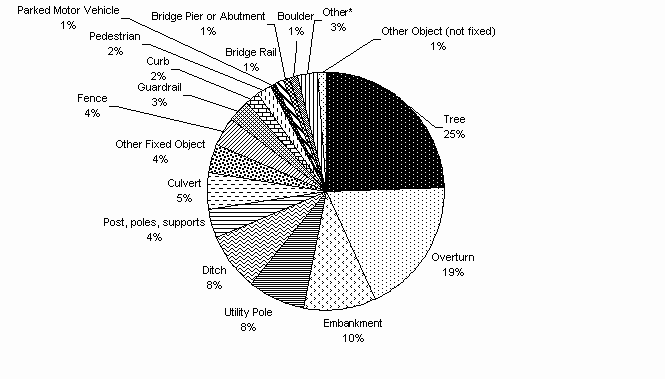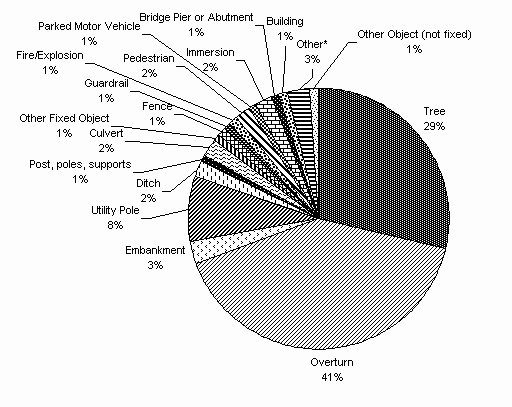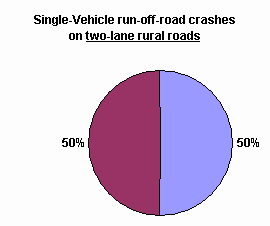
The 1999 statistics from the Fatality Analysis Reporting System (FARS) show that nearly 39 percent of the 37,043 fatal crashes were single-vehicle ROR crashes on various road types.(See Exhibit 1). For two-lane undivided non-interchange non-junction roadways exclusively, there were 8,901 (24 percent) single-vehicle ROR crashes. Exhibit 1 shows how single-vehicle ROR crashes on two-lane roads are distributed by roadway functional classification. There are more than twice as many ROR fatal crashes on rural roads than urban, partly due to the higher speeds on rural roads, and partly to their greater mileage.
Exhibits 3 and 4 show the distribution of ROR crashes by First Harmful Event
and Most Harmful Event for the same accident and roadway type, the latter being
of higher severity (i.e., death) and the former being the first event or object
hit, which may or may not have resulted in injury or fatality. Attention should
be focused on the first harmful event for strategies that deal with eliminating
or protecting drivers from various roadside objects; and to the most harmful
event for strategies that minimize the severity of crashes when collisions with
such objects occur. As noted, the objects that are hit most often are trees.
Distribution of Single-Vehicle Run-Off-Road Fatalities on Two-Lane Undivided Non-Interchange Non-Junction Roads by Highway Type (Source: 1999 FARS Data)

Distribution of Single-Vehicle Run-Off-Road Fatalities for Two-Lane Undivided Non-Interchange/Junction Roads by First Harmful Event (Source: 1999 FARS Data)
* Other includes events which each represent less than 0.5% of the total first harmful events: bridge parapet end, immersion, shrubbery, longitudinal barriers (concrete or other), pedal cycle, other non-collision, fire hydrant, snow bank, fell/jumped from vehicle, transport device used as equipment, animal, unknown, pavement surface irregularity, fire/explosion, other type non-motorist, vehicle occupant struck or run over by own, impact attenuator/crash cushion, railroad train, gas inhalation.

Distribution of Single-Vehicle Run-Off-Road Fatalities for Two-Lane Undivided Non-Interchange Non-Junction Roads by Most Harmful Event (Source: 1999 FARS Data)
* Other includes events which each represent less than 0.5% of the total first harmful events: bridge parapet end, immersion, shrubbery, longitudinal barriers (concrete or other), pedal cycle, other non-collision, fire hydrant, snow bank, fell/jumped from vehicle, transport device used as equipment, animal, unknown, pavement surface irregularity, fire/explosion, other type non-motorist, vehicle occupant struck or run over by own, impact attenuator/crash cushion, railroad train, gas inhalation.

While vehicles are more likely to leave the roadway along curves, most run-off-road fatalities on all roads and on two-lane rural roads are on tangent sections as shown in Exhibit 5 below. For all roads, 42 percent of the 1999 ROR fatal crashes were on curves and 58 percent on tangents. For two-lane rural roads, the percentage of ROR fatal crashes on curves increased to 50 percent. The fact that more crashes occur on tangents for all roads, most likely reflects the fact that the majority of road sections are tangent. However, it is clear that both tangents and curves have significant problems and warrant treatment.
Distribution of Single-Vehicle Run-off Road Crashes between Tangent and Curved Sections
 |
 |
As would be expected, the major damage in a ROR crash is associated with roadside features. FARS data for all roadway classes indicate that the Most Harmful Event is most likely to be an overturn (42.1 percent of 1999 ROR single-vehicle fatalities), an impact with a tree (25.4 percent), an impact with a utility pole (7.2 percent), or an impact with a ditch or embankment (4.9 percent). Most other roadside objects (e.g., culverts, posts, guardrails, etc.) are found to be the Most Harmful Event in 2 percent or less of the fatalities. For two-lane rural roads, the percentages for Most Harmful Event are similar – overturn (44.5 percent of 1999 ROR single-vehicle fatalities), an impact with a tree (28.7 percent), an impact with a utility pole (8.0 percent), or an impact with a ditch or embankment (5.0 percent). As all of these features are either necessary elements of the roadway, commonly found along the roadside, or both, it is clear that strategies are needed to protect the vehicle and its occupants in cases where it has failed to remain on the roadway.